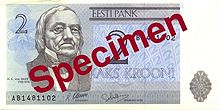The 2 krooni banknote (2 EEK) is a denomination of the Estonian kroon, the former currency of Estonia. Karl Ernst von Baer, who was an Estonian Baltic German anthropologist, naturalist and geographer (1792–1876), is featured with a portrait on the obverse. The 2 krooni bill is called sometimes a "kahene" meaning "a two".


A view of Tartu University which was founded in 1632 is featured on the reverse. Before the replacement of the EEK by the euro, the 2 krooni banknote was the smallest denomination most commonly used by Estonian residents on an everyday basis. It can be exchanged indefinitely at the currency museum of Eesti Pank for €0.13.
History of the banknote
edit- 1992: first series issued by the Bank of Estonia;
- 2006: second series issued;
- 2007: third series issued;
- 2011: withdrawn from circulation and replaced by the euro
Security features
editSource: [1]
- 1992
- On the right-hand side of the banknote there is a watermark depicting the Tall Hermann Tower of Toompea Castle.
- The paper of the banknotes contains security fibres of different colour.
- Each note contains a security strip.
- Each banknote has a seven-digit serial number printed in black.
- 2006
- Portrait watermark.
- Dark security thread with transparent text "2 EEK EESTI PANK".
- Microprint, repeated text "EESTI PANK".
- Tactile intaglio-printed elements.
- Latent number "2".
- Signatures. Governor, Chairman of the Board.
- Anti-copier line-structure.
- UV-fluorescent fibres glowing green.
- UV-fluorescent security thread glowing blue.
- UV-fluorescent rectangle with the denomination "2".
- Serial numbers.
See also
editReferences
editExternal links
editWikimedia Commons has media related to Money of Estonia.